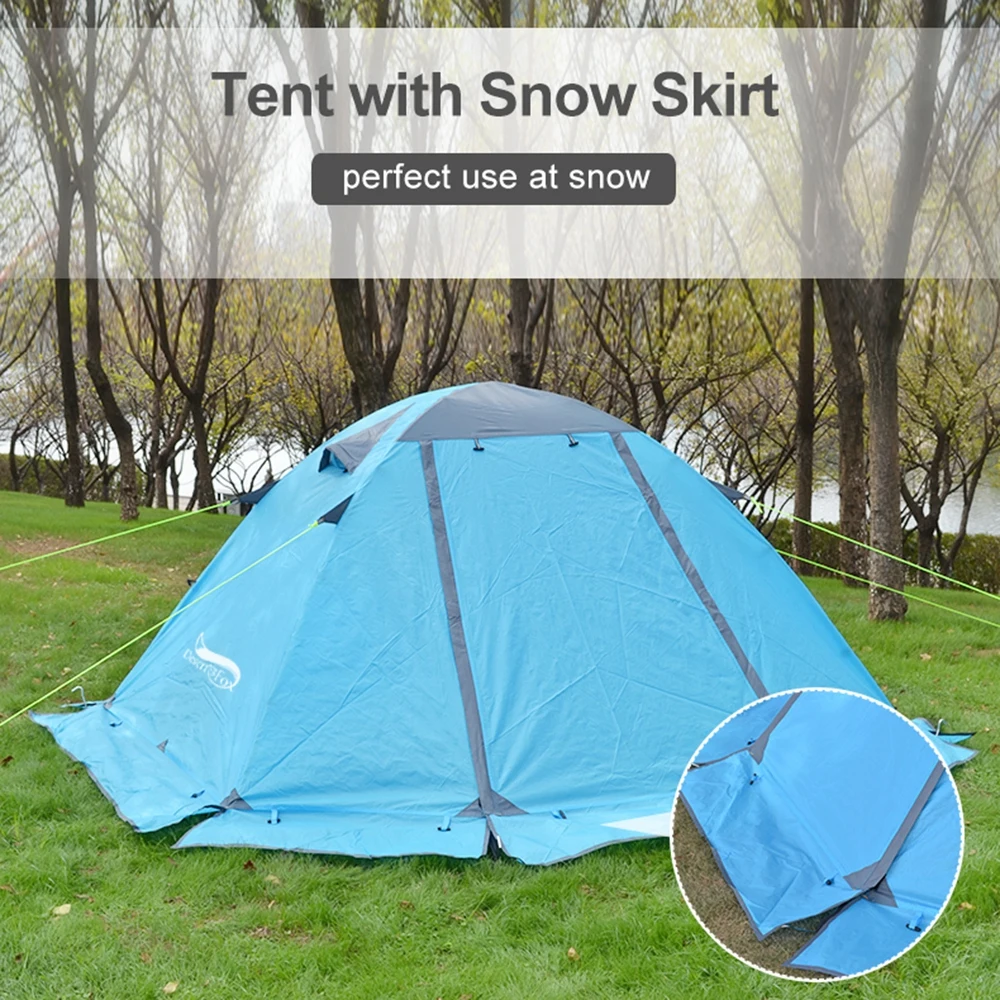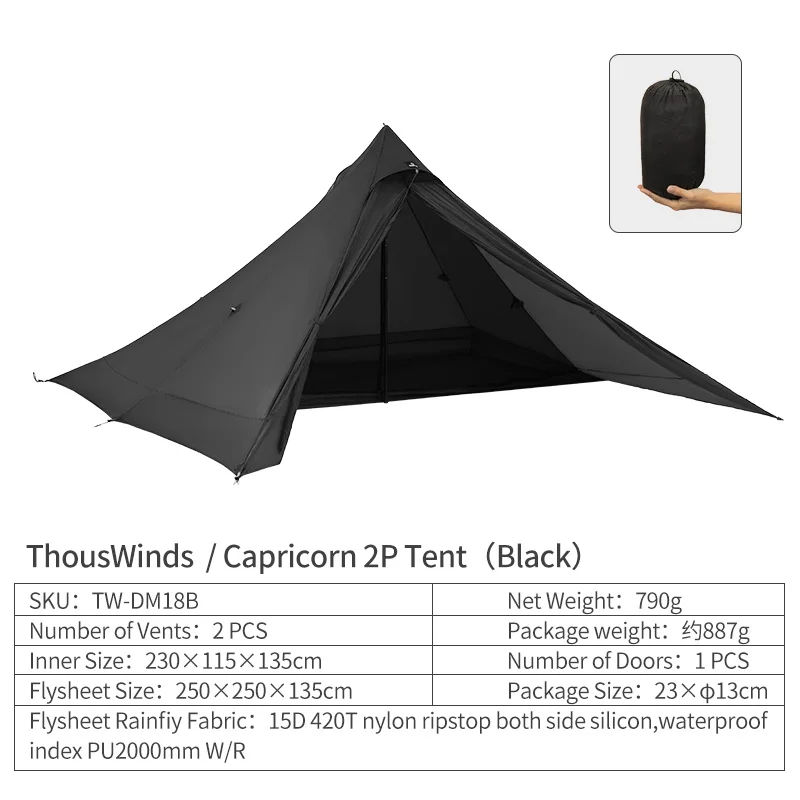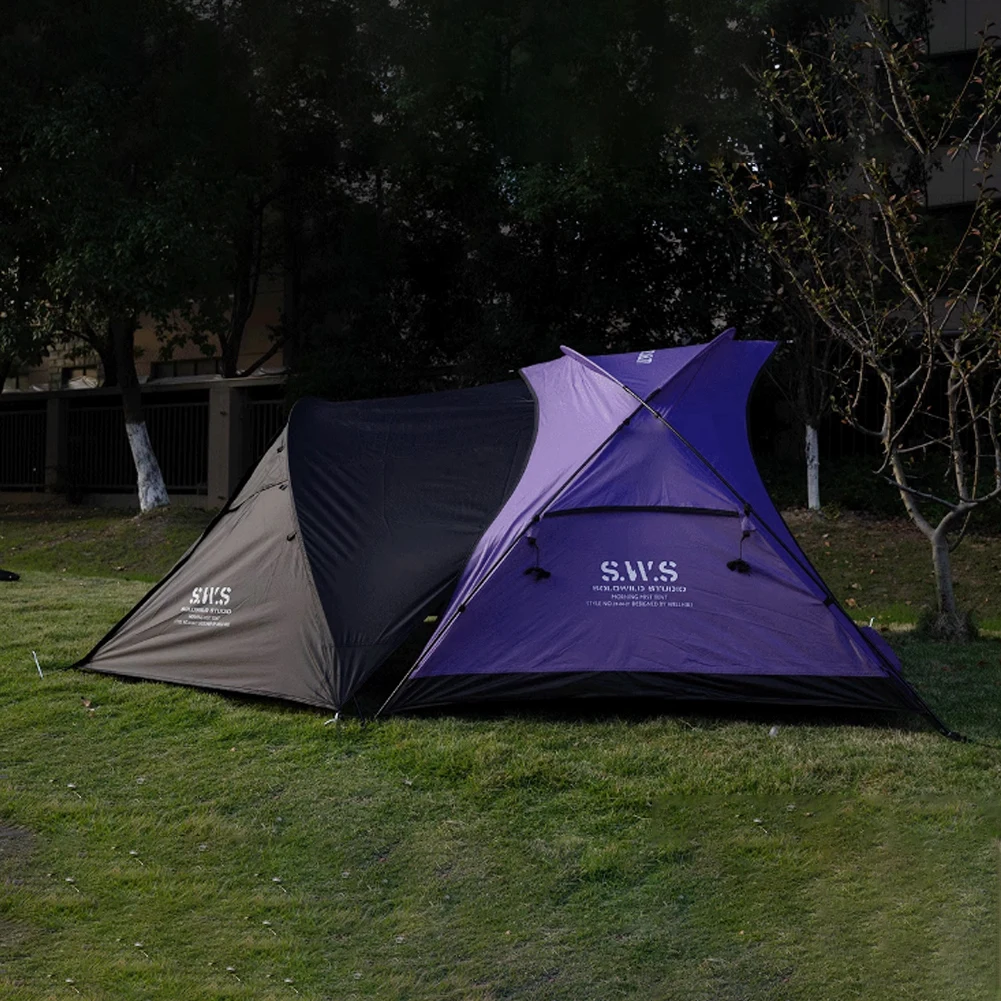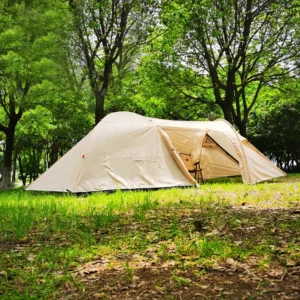Understanding All-Season Tent Material Fundamentals
When it comes to outdoor adventures, your tent is your home away from home—your shield against whatever Mother Nature throws your way. But what exactly makes a tent truly “all-season”?
An all-season tent isn’t just marketing jargon; it refers to shelters specifically designed to perform across a wide spectrum of weather conditions. These tents must maintain a delicate balance between durability, weather resistance, and reasonable portability. Unlike seasonal tents, all-season options need to withstand everything from summer heat to winter snow.
The materials chosen for these tents directly influence how they’ll perform when you’re:
– Camping in desert heat (up to 100°F/38°C)
– Setting up camp during spring downpours
– Enduring autumn’s unpredictable winds
– Hunkering down in winter conditions (as low as -20°F/-29°C)
Selecting the right durable tents for all seasons requires understanding how different materials respond to these varied challenges. The best all-season tents don’t just survive harsh conditions—they provide reliable protection while remaining practical to carry and set up.
Throughout this guide, we’ll explore how specific materials contribute to a tent’s ability to handle snow loads, heavy rain, high winds, and intense UV exposure. The features and benefits of four-season tents extend far beyond simple material choices to include thoughtful design elements that work together as a complete system.
Tent Fabrics: The Primary Defense Against the Elements
The outer fabric of your tent serves as your first line of defense against weather extremes, making it perhaps the most critical component of an all-season shelter. Different fabric types offer varying benefits for different conditions.
Nylon
Nylon remains the most popular choice for quality tents due to its exceptional strength-to-weight ratio. In all-season tents, you’ll typically find:
– Higher denier ratings (30-70D) for improved durability
– Ripstop weave patterns that prevent tears from spreading
– Good flexibility in cold conditions
However, nylon has a significant drawback—it naturally absorbs water, which causes it to stretch when wet. This can lead to a saggy tent during rainstorms unless properly tensioned.
Polyester
Polyester has gained popularity for all-season tents because it:
– Maintains tension when wet (minimal stretching)
– Offers superior UV resistance compared to nylon
– Typically comes in heavier weights (68-75D) for all-season models
– Dries faster than nylon
These properties make polyester particularly valuable for extended trips where the tent will face prolonged exposure to sunlight and moisture.
Dyneema/Cuben Fiber
For those seeking ultralight solutions regardless of price, Dyneema (formerly called Cuben Fiber) offers remarkable properties:
– Incredibly lightweight yet waterproof without additional coatings
– Exceptional tear strength
– Zero stretch when wet
– Extremely packable
The downside? Dyneema tents can cost three times more than comparable nylon models, making them a specialized choice for serious adventurers.
Cotton/Canvas
Traditional materials still have their place in the all-season world:
– Excellent breathability and condensation management
– Natural insulation properties (warmer in winter, cooler in summer)
– Quiet in wind and rain (no plastic “crinkle”)
– Extremely durable with proper care
The significant tradeoff is weight—canvas tents are substantially heavier than synthetic options, making them better suited for base camping rather than backpacking.
Understanding the materials used in waterproof hiking gear helps you make informed decisions about which fabric best suits your needs. Many outdoor enthusiasts find that exploring waterproof camping tent options reveals how these materials perform in real-world conditions.
Waterproofing Technologies: Keeping Dry in Downpours
A tent’s waterproofing capability is measured by its hydrostatic head rating—essentially how much water pressure the fabric can withstand before leaking. For all-season performance, look for:
- Flysheets: Minimum 1,500mm hydrostatic head (3,000+mm recommended for serious rain)
- Tent floors: 3,000-10,000mm for reliable ground moisture protection
Several waterproofing technologies dominate the market, each with distinct advantages:
Polyurethane (PU) Coatings
The most common waterproofing approach involves applying polyurethane layers to the fabric:
– Cost-effective solution found in most mid-range tents
– Provides reliable waterproofing in moderate conditions
– Can degrade over time, especially with UV exposure and storage in hot conditions
– Generally needs reapplication after several seasons of heavy use
Silicone Coatings
Premium tents often feature silicone-treated fabrics (silnylon or silpoly):
– Superior durability compared to PU coatings
– Better long-term water repellency
– More flexible in cold conditions
– Usually more expensive
– Some versions use silicone on the outside and PU on the inside (Si/PU) for better seam sealing
Durable Water Repellent (DWR) Treatments
These treatments cause water to bead up and roll off rather than saturating the fabric:
– Often applied as an additional layer over other waterproofing
– Prevents the outer fabric from becoming saturated (wetted out)
– Maintains breathability while shedding precipitation
– Requires periodic reapplication as it wears off with use
Understanding how weather resistance affects durability in camping tents helps you appreciate why proper waterproofing is about more than just staying dry—it’s about maintaining your shelter’s structural integrity in challenging conditions.

Frame Materials: Structural Integrity in All Conditions
A tent’s frame provides its skeleton, determining how it will stand up to wind, snow loads, and general use. The material choice dramatically affects performance, weight, and price.
Aluminum Alloy
The gold standard for all-season tents, aluminum poles offer an excellent balance of properties:
– Types: 7000-series aluminum (like 7001-T6) provides the best strength-to-weight ratio
– Diameters: 8.5-11mm for all-season tents (thicker for winter-specific models)
– Benefits: Lightweight, durable, and maintains flexibility in cold temperatures
– Drawbacks: More expensive than fiberglass, can bend under extreme loads
Carbon Fiber
An ultralight alternative gaining popularity in premium tents:
– 30-40% lighter than comparable aluminum poles
– Exceptional strength in ideal conditions
– Limitations: More brittle in extreme cold, catastrophic rather than gradual failure
– Price: Significantly more expensive than aluminum options
Fiberglass
Common in entry-level tents but rarely suitable for true all-season use:
– Benefits: Inexpensive, adequate for mild conditions
– Drawbacks: Heavy, brittle in cold weather, prone to splintering when broken
– Verdict: Generally not recommended for serious all-season camping
Frame Design Considerations
Beyond material, how poles are arranged significantly impacts performance:
– Dome designs: Good balance of strength and interior space
– Geodesic/semi-geodesic: Multiple pole crossings create superior stability for harsh conditions
– Tunnel designs: Excellent space efficiency but requires proper staking in wind
– Pole attachment systems: Sleeves provide more stability while clips offer easier setup
Serious adventurers seeking the ultimate in storm protection should explore heavy duty 4 season tent options, which feature reinforced frames specifically designed for extreme conditions. Understanding what makes a tent windproof provides valuable insights into how frame materials contribute to overall durability.
Comprehensive Tent Design: Putting Materials Together
Even the finest materials will fail if not effectively integrated into a cohesive design. All-season tents require thoughtful engineering to ensure each component works together to combat nature’s challenges.
Design Shapes for Weather Resistance
Different tent geometries excel in different conditions:
– Low-profile domes: Excellent wind shedding from all directions
– Extended vestibules: Provide protected cooking/storage space in bad weather
– Steeper walls: Better for shedding snow and preventing pooling
– Guy-out points: More attachment points mean better stability in high winds
Critical Construction Details
The devil is in the details when it comes to all-season performance:
– Seam construction: Fully taped seams prevent water penetration at stitch lines
– Reinforcement points: Extra fabric at corners and high-stress areas prevents tears
– Guy line attachments: Should be integrated into the tent body, not just sewn onto fabric
– Zipper protection: Flaps and water-resistant zippers keep moisture out of the tent
Seasonal Adaptability Features
True all-season tents include features that allow adaptation to changing conditions:
– Removable rain flies for ventilation in good weather
– Adjustable vents that can be closed in storms or opened for airflow
– Vestibule designs that accommodate cooking in poor weather
– Convertible panels that change from mesh to solid fabric
These design elements work in concert with quality materials to create shelters capable of handling diverse environments. The 4 season winter 2 person tents category showcases how these design principles come together in practical, field-tested forms.
Floor Materials: The Ground Defense System
The tent floor endures constant abuse—from rocky ground to pooling water to abrasive sand. Floor materials must balance durability with weight considerations.
Floor Material Weight and Strength
- Lightweight floors: 40-70D fabrics suitable for careful users and maintained campsites
- Standard all-season: 70-100D provides good durability for varied terrain
- Expedition grade: 100-150D materials stand up to extreme conditions and rough ground
Waterproofing for Ground Contact
Floor materials require significantly higher waterproofing standards than rainflies:
– Minimum recommended: 3,000mm hydrostatic head
– All-season standard: 5,000-6,000mm for reliable performance
– Expedition grade: 8,000-10,000mm for standing water and snow melt
Floor Designs for Maximum Protection
The physical construction of the floor contributes significantly to its performance:
– Bathtub floors: Extend 4-6 inches (10-15cm) up the tent walls to prevent seepage
– Reinforced corners: Extra material or double layering at high-stress points
– Taped seams: Critical for preventing water entry at stitch lines
– Footprint compatibility: Ability to add an additional ground layer for extra protection
Balancing tent materials and pack weight requires understanding which floor materials provide the best protection for your specific needs. Many campers find that exploring waterproof backpacking tent options helps them understand how floor materials affect overall tent performance and durability.

Ventilation Systems: Managing Temperature and Condensation
Even the most waterproof tent will feel wet inside without proper ventilation. Condensation management is especially critical in all-season tents, which must balance airflow with weather protection.
Mesh Types and Placement
Different mesh materials serve different purposes:
– No-see-um mesh (20-50 holes per inch): Blocks even the smallest insects while allowing airflow
– Standard mesh: Provides better air circulation but less insect protection
– Winter-specific mesh: Limited use in cold-weather tents to reduce heat loss
Double-Wall vs. Single-Wall Design
The tent’s basic construction dramatically affects ventilation:
– Double-wall tents: Separate inner tent and rainfly create air circulation between layers
– Single-wall tents: Lighter but more condensation-prone unless using specialized breathable-waterproof fabrics
– Hybrid designs: Strategic mesh panels and vents in single-wall construction
Strategic Vent Positioning
Effective ventilation requires thoughtful vent placement:
– High/low venting: Creates natural convection airflow
– Adjustable openings: Allow adaptation to changing conditions
– Protected vents: Designed to remain open even during rainfall
– Cross-ventilation options: Multiple openings that create airflow paths
Mastering tent insulation for year-round camping requires understanding how ventilation systems work with other tent features to maintain comfort in varying conditions.
Seasonal Material Performance Analysis
The true measure of all-season tent materials is how they perform across different environmental challenges. Each season presents unique demands that require specific material properties.
Winter Performance Requirements
Cold-weather camping demands the most from tent materials:
– Higher denier fabrics (70D+) for durability under snow loads
– Stronger poles (often 9-11mm aluminum or carbon fiber)
– Limited mesh to retain warmth
– Steeper walls to shed snow effectively
– Materials that remain flexible in sub-freezing temperatures
Summer Adaptations
Hot weather creates different challenges:
– Maximum ventilation through strategic mesh placement
– UV-resistant fabrics to prevent degradation
– Lighter weight designs for improved portability
– Reflective coatings to reduce heat absorption
Spring/Fall Considerations
Transitional seasons often bring the most variable conditions:
– Versatile ventilation systems that can adapt to temperature changes
– Robust waterproofing for unexpected storms
– Wind-resistant designs for seasonal gusts
– Quick-drying materials for morning dew and intermittent rain
Understanding how multi-season tents perform in variable climates helps you select materials appropriate for your typical camping conditions. For dedicated cold-weather adventurers, exploring winter camping tent options reveals specialized material combinations designed for extreme conditions.
Lightweight Backpacking Tent, Ultralight Backpacking Tent, Waterproof Backpacking Tent
$391.05 Select options This product has multiple variants. The options may be chosen on the product pageHeavy Duty 4 Season Tent, Mountaineering Tent, Winter Camping Tent
$870.40 Select options This product has multiple variants. The options may be chosen on the product pageCompact Backpacking Tent, Lightweight Backpacking Tent, Waterproof Camping Tent
$335.52 Select options This product has multiple variants. The options may be chosen on the product pageUltralight Backpacking Tent, Ultralight Dome Tent, Winter Camping Tent
Price range: $369.63 through $370.07 Select options This product has multiple variants. The options may be chosen on the product pageCamping Tent with Vestibule, Waterproof Camping Tent
Price range: $407.89 through $479.48 Select options This product has multiple variants. The options may be chosen on the product pageHeavy Duty 4 Season Tent, Ultralight Freestanding Tent, Winter Camping Tent
$3,722.66 Select options This product has multiple variants. The options may be chosen on the product page
Specialized Materials for Extreme Conditions
Beyond typical four-season use, specialized environments demand unique material properties. These advanced materials often represent the cutting edge of outdoor fabric technology.
High Altitude Adaptations
When camping above treeline or in alpine environments:
– Enhanced UV protection (fabrics with UPF 50+ ratings)
– Stronger frames to handle increased wind exposure
– Materials tested for extreme temperature fluctuations
– Specialized aluminum alloys that maintain strength at high elevations
Desert Performance Materials
Hot, dry environments create distinct challenges:
– Heat-reflective outer coatings to reduce interior temperatures
– Sand-resistant zippers with protected coils
– UV-stabilized fabrics that resist degradation in intense sunlight
– Abrasion-resistant floors for rocky, sandy terrain
Arctic/Extreme Cold Specialization
The most demanding conditions require the most advanced solutions:
– Specialized pole designs to withstand heavy snow loads
– Fabrics that remain flexible at temperatures below -20°F (-29°C)
– Reduced mesh areas or closable mesh panels
– Extra guy-out points for stability in high winds
– Vestibule designs that accommodate snow management
For those venturing into the most challenging environments, the 4 season tents ultimate guide provides vital information on materials engineered specifically for extreme conditions.

Is It Worth the Investment? Value Assessment
All-season tents represent a significant investment compared to seasonal options. Understanding the value proposition helps you make an informed decision about where to invest your outdoor gear budget.
Material Quality and Price Correlation
- Entry-level all-season tents ($100-200): Usually feature polyester fabrics with basic PU coatings and fiberglass poles
- Mid-range options ($200-400): Typically offer nylon or polyester with improved coatings and aluminum poles
- Premium models ($400+): Feature high-denier fabrics with advanced waterproofing and specialized pole systems
Longevity Considerations
Quality materials directly impact how long your tent will last:
– Budget tents: Typically 1-3 seasons of regular use before significant degradation
– Quality all-season tents: Often deliver 5-10+ years of reliable performance with proper care
– Key failure points: UV degradation of fabrics, coating breakdown, pole stress fractures
Investment Priorities
If working with a limited budget, prioritize these areas:
– Rainfly waterproofing: The primary defense against precipitation
– Pole quality: Structural failure can render a tent completely unusable
– Floor durability: Ground contact creates constant abrasion challenges
– Seam construction: Often the first point of failure in lesser tents
The best all-season tent performance, durability, and value comes from understanding which material features provide the most significant benefits for your specific camping style and environment.
Essential Care and Maintenance for All-Season Materials
Even the most advanced tent materials require proper maintenance to deliver years of reliable performance. Following these guidelines will significantly extend your tent’s useful life.
Cleaning and Storage Protocols
- Clean gently using non-detergent soap and lukewarm water
- Never machine wash or dry tent fabrics
- Always store completely dry to prevent mildew and coating degradation
- Store loosely packed in a cool, dry location (not compressed in a stuff sack)
Waterproofing Maintenance
- Inspect seam tape regularly and repair as needed
- Reapply DWR treatments when water stops beading on the rainfly
- Use manufacturer-recommended products for specific fabric types
- Pay special attention to high-wear areas like floor corners and door areas
Field Repairs
Every all-season camper should carry:
– Seam sealer appropriate for your tent’s fabric type
– Tenacious Tape or similar repair patches
– Pole repair splints
– Multi-tool for improvised fixes
Following these maintenance practices will ensure your tent continues to perform as designed, even when navigating through nature’s fury with durable tents.
FAQ: Common Questions About All-Season Tent Materials
Can a tent truly be suitable for all seasons?
Yes, though with some limitations. True all-season tents balance features to perform adequately across varied conditions but may not be optimal for extreme environments. The most versatile designs include adaptable features like convertible mesh panels and adjustable ventilation.
Is denier the only measure of fabric durability?
No. While denier indicates thread thickness, other factors like weave pattern (especially ripstop construction), fiber quality, and coating durability also significantly impact overall strength. A well-made 70D fabric can outperform a poorly constructed 100D material.
How often should waterproof coatings be reapplied?
This depends on usage patterns and storage conditions. Generally, DWR treatments need refreshing every 10-20 days of field use. Full waterproof coatings typically last longer—often several years—before requiring attention. When water no longer beads up on your rainfly, it’s time for reapplication.
Are factory seam seals reliable or should I apply my own?
Quality tents come with reliable factory seam sealing. However, it’s worth inspecting the seams before your first major trip and periodically thereafter. Additional seam sealing is rarely needed initially but may become necessary after extended use, especially in high-stress areas.
How important is tent shape for snow handling?
Extremely important. Dome and geodesic designs with steep wall angles naturally shed snow, while flatter roof sections can accumulate dangerous weight. For winter camping, tent shapes for effective snow shedding are essential to prevent collapse during snowfall.
Glossary of Tent Material Terms
Denier (D): Measurement of thread thickness; higher numbers indicate thicker, more durable (but heavier) fabrics.
DWR (Durable Water Repellent): Surface treatment that causes water to bead up and roll off fabric rather than saturating it.
Hydrostatic Head (HH): Measurement of water resistance expressed in millimeters; indicates how much water pressure fabric can withstand before leaking.
PU (Polyurethane): Common waterproof coating applied to tent fabrics.
Ripstop: Fabric weaving technique that incorporates reinforcement threads to prevent tears from spreading.
Silnylon/Silpoly: Nylon or polyester fabrics treated with silicone for waterproofing and durability.
TPU (Thermoplastic Polyurethane): Advanced waterproof coating with better flexibility and durability than standard PU.
YKK: Premium zipper manufacturer; often specified in quality tents.
DAC: Brand name for high-quality aluminum tent poles made by Korean company Dongah Aluminum.
PE (Polyethylene): Durable, waterproof material often used for tent footprints and heavy-duty flooring.







